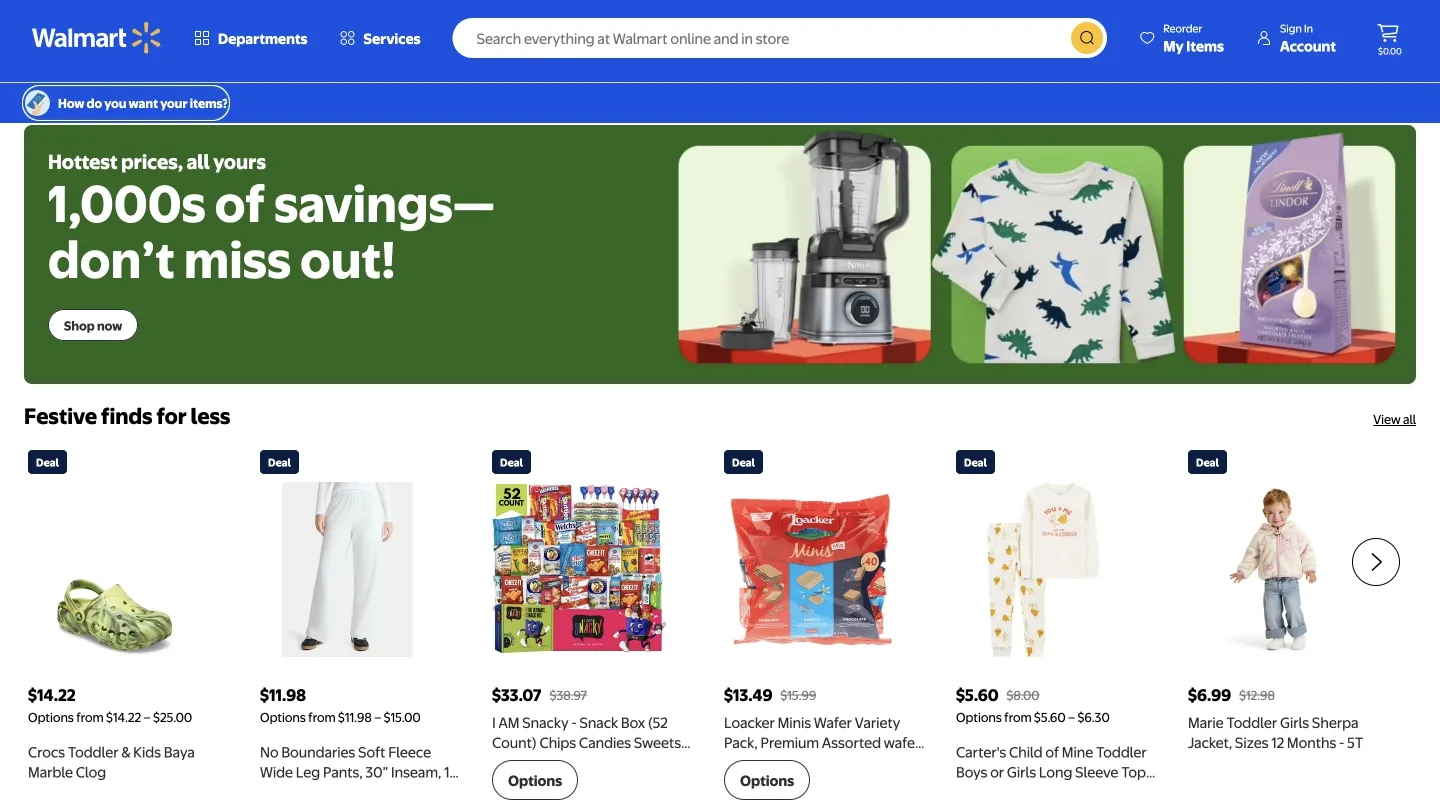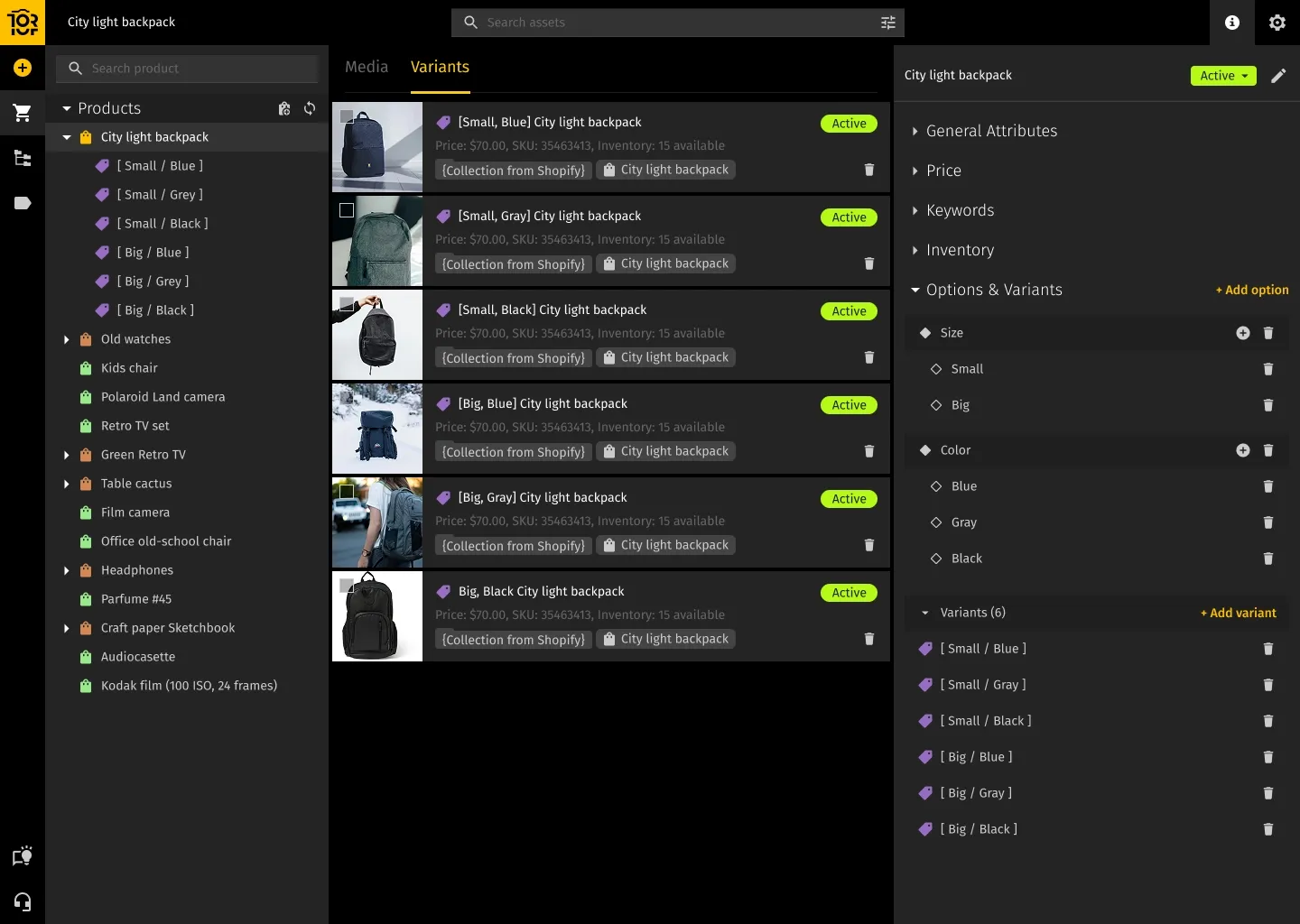In this article, you’ll learn:
Your product is solid. Your catalog… maybe not.
On Monday, Amazon shows one set of specs. By Wednesday, Walmart showed another because someone used an old spreadsheet. Your DTC site is missing compliance details. Returns creep up, ratings slide, support tickets grow. In e-commerce, insufficient data is often as costly as a bad product.
In one consumer study of more than 1,500 online shoppers, 40% said they had returned an online purchase in the previous year specifically because the product information was inaccurate or incomplete.
Modern brands run dozens of catalogs in parallel: marketplaces, DTC, social commerce, B2B portals, retail feeds, and in-store systems. Each has its own rules. If your product data lives in scattered files and is manually updated, errors stop being exceptions and become your regular.
Product catalog management (PCM) is how you keep that from happening: you structure product data once, keep it clean, and push it accurately into every channel.
I’ve written this article to help you understand how to centralize and scale product data across global e-commerce channels.
Key Takeaways
| Topic | Key takeaway | Why it matters | What to do first |
|---|---|---|---|
| Presence ≠ performance | Having listings live doesn’t mean you’re winning. If you don’t rank, convert, or hold the Buy Box, you’re invisible. | Many brands think “we’re on Amazon” is enough and miss the revenue leaking through weak execution. | For 5–10 hero SKUs, check: rank, conversion rate, rating, review count, stock history, price vs top competitors. |
| Search & visibility | Search rank is the front door. If you’re not on page one for key terms, most shoppers never see you. | Most clicks go to the first few results; page two is basically “no man’s land.” | Identify your top 10–20 high-intent keywords per channel and track your rank for them at least weekly. |
| Content & conversion | PDPs are landing pages. Titles, bullets, images, video, and attributes decide whether clicks turn into orders. | Better content = higher conversion = stronger ranking signals. Weak content does the opposite. | Take your top 5 SKUs and upgrade PDPs: clear titles, full specs, 5–7 images, 1 short video, FAQ/Q&A cleanup. |
| Availability & operations | Out of stock doesn’t just lose sales today — it also hurts rankings and is slow to recover. | You can’t win the shelf if your products aren’t reliably available where people shop. | Track in-stock rate for key SKUs per channel; set alerts or simple rules so OOS gets fixed fast. |
| Data foundation (PIM/DAM) | Without a single source of truth for product data and assets, every update is slow, manual, and inconsistent. | Dirty, scattered data kills speed, breaks listings, and makes optimization painful. | Map where product info lives today. Start consolidating to (or planning) a PIM + DAM as your backbone. |
| Reviews & Q&A | Ratings, review volume, and answered questions are core trust and ranking signals. | Low ratings or too few reviews can sink even a good product; fresh reviews keep you relevant. | Set up simple, automated review requests and a habit of answering Q&A and key negative reviews. |
| Pricing & promotions | Price shapes both shopper choice and algorithm favorability. Promos should create momentum, not just margin loss. | Overpriced vs peers = fewer clicks and sales; permanent discounts = trained bargain hunters. | For key SKUs, compare your price against top 3–5 competitors and define basic rules for when to discount. |
| Retail media | Ads should amplify listings that already convert, not compensate for bad PDPs. | Paying for clicks to weak pages just wastes budget and sends bad conversion signals. | Audit your top ad destinations: pause spend on PDPs with poor content/rating until you fix the fundamentals. |
| Continuous optimization | The digital shelf moves constantly; treating it as a one-time project guarantees you fall behind. | Competitors, algorithms, and shopper behavior don’t sit still. You can’t either. | Create a simple monthly or bi-weekly routine: review rankings, content gaps, reviews, pricing, and stock — and assign owners to fixes. |
What Is Product Catalog Management?
A product catalog is the structured record of what you sell: identifiers, titles, descriptions, attributes, prices, stock, and the images, videos, and documents that describe a product in context. It answers three questions at once: what this product is, how it’s organized, and how it appears wherever a customer might see it.
When your product catalogs are fragmented, even basic product options and attributes become hard to manage and keep up to date.
Twenty years ago, that catalog lived in a printed book and maybe a simple website. Now, the exact product might appear on Amazon, Walmart, Shopify, TikTok Shop, Google Shopping, a B2B portal, and a retailer’s internal system, in several languages and currencies, and in accordance with local rules and regulations. The catalog is no longer a book or a page. It’s infrastructure.

Product catalog management is the discipline behind that infrastructure. It’s how you decide what fields products have, who fills them in, who approves changes, which systems are allowed to edit, and how updates flow from one source of truth into every channel you care about.
A modern product catalog is a structured store of product attributes, pricing, and accurate product information for all your products and services.
At a small scale, this can be a spreadsheet and a set of rules. At tens of thousands of SKUs, across multiple brands and regions, it’s a central platform with clear workflows and tight integrations with ERP, WMS, DAM, and marketplaces.
Core Elements of a Modern Catalog
Your product catalog has several layers: categories, product types, attributes, pricing, inventory, and the digital assets and product imagery that bring products to life.
Taxonomy and categories
Taxonomy is how you break the assortment into something humans and algorithms can navigate. “Shoes / Shirts / Pants” works for a tiny range; it breaks once you grow. As you expand, you move toward a tree (e.g., Electronics → Televisions → Smart TVs → 4K Smart TVs) and layer filters like brand, price, size, material, and key features on top. Good taxonomy makes products discoverable everywhere: on your site, in internal search, and on marketplaces.

Attributes and variants
Attributes are the specifics: dimensions, materials, capacities, compatibilities, certifications, flavors, and sizes. Variants multiply those specifics quickly. One T-shirt style, in five sizes and four colors, already equals 20 SKUs. If you treat each of those as a separate product and copy data between them, you’re committing to rewriting the same information again and again.
Parent–child structures solve that. You define one master product, let variants inherit shared attributes, and override only what differs. Update a detail once, and every variant picks it up.
Digital assets
Images, videos, manuals, spec sheets, safety documents — all of this sits around the core text and numbers. A Digital Asset Management (DAM) system stores those files, tags them, versions them, and ties them to product records so that when you replace a hero image or upload a new manual, the change flows through every channel that uses it. A product information management system (PIM) helps you define and control these attributes and digital assets in one place instead of spreading them across multiple systems.
Pricing, availability, relationships
Real pricing takes into account regional differences, B2B tiers, promotions, and sometimes channel-specific rules. Availability includes stock, lead times, and delivery options. Relationships link products into bundles, compatible accessories, and upgrades. These aren’t “nice extras”; they are part of the catalog and drive how products show up, how they’re sold, and what customers see next.
Common Catalog Management Problems
Most brands that feel catalog pain exhibit similar patterns.
Fragmented data
Product data is spread across ERP systems, spreadsheets, CMS systems, supplier files, marketplace accounts, and people’s desktops. When product data lives in multiple systems with no central data management, data quality quickly degrades and nobody knows which version is up to date. Research on retail websites shows that inaccurate or incomplete product information directly leads to dissatisfied customers and profit losses — exactly the pattern teams see when catalog data lives in disconnected systems.
Weak data quality and no owner
Missing attributes, duplicate values, typos in materials or colors, wrong GTINs, inconsistent units — everyone notices the symptoms, but no one actually owns the cure. Without clear responsibility and simple rules, quality drifts. Without clear ownership and control, maintaining consistency and accurate product information across channels turns into a never-ending firefight.
Complex assortments and localization
Variants and international expansion multiply the number of records you need to manage. If you duplicate entire product records for each market, every small change becomes a multi-country cleanup project.
Unsynchronized channels
Different teams tweak “their” channels in isolation. The website gets updated copy, Amazon gets a new image, and the B2B portal keeps old specs. Over time, the exact product tells different stories in different places.
Chaotic collaboration
Suppliers, agencies, translators, compliance, and internal teams all touch product data. If the workflow is basically “send me your latest Excel file,” launches slip, updates get lost, and every change takes longer than it should.
Tools and Architectures
Most growing businesses eventually outgrow spreadsheets and start looking at catalog management software or a dedicated product information management system (PIM system).
The PIM becomes the place where product data is modeled, enriched, approved, and pushed out to channels. It doesn’t replace ERP, WMS, or CMS; it sits between them, coordinating product content.
Alongside PIM, a Digital Asset Management (DAM) system organizes visual and document assets and links them to products. In larger enterprises, a Master Data Management (MDM) layer sits above everything, ensuring core identifiers and reference data remain consistent across the entire company.
A modern product catalog management software platform integrates with your e-commerce platform, order management system, and other catalog management tools so you don’t have to manage the same data in multiple systems.
Most modern PIM and DAM systems are delivered as SaaS: hosted by the vendor, accessed via browser, integrated through APIs and connectors. Some brands choose open-source or self-hosted options for specific reasons. Still, the architectural idea remains the same: one place for product data and assets to live, clear rules around who can touch them, and reliable ways to get them into every channel.
How to Get Started: A Practical Path
You don’t need a massive transformation program to begin. A simple path looks like this:
- Audit what you have now.
- List where product data lives, who edits it, and how a new product moves from idea to live listing. Take a small sample of SKUs and compare them side by side across channels to see fundamental gaps.
- Decide who owns what.
- Name a person who owns Catalog Health overall. Assign clear responsibility for descriptions, specs, pricing, compliance data, and assets. Without this step, everything else slips.
- Design a lean data model and taxonomy.
- Define what a “complete” record looks like for each product type and how categories should be structured. Test the model with real products; if it feels overcomplicated or doesn’t fit, simplify.
- Choose tools that fit your current scale.
- For a modest catalog and a handful of channels, a mid-market PIM with basic workflows and connectors is usually enough. For big, multi-region, multi-channel portfolios, you’ll want something more advanced. The key is that it can represent your model and connect to your systems.
- Clean, migrate, and enforce.
- Deduplicate, standardize names and values, fix units, and fill in glaring gaps before migrating. Move data in batches, validate imports, and turn on validation and completeness checks so the catalog doesn’t start falling apart again the day after go-live.
Once a small, focused slice of your catalog runs smoothly through this setup — for example, your top SKUs on your top channels — you repeat the pattern for the rest.
What Changes When You Get This Right
Better catalog management is felt first by customers. Product pages stop feeling vague and inconsistent. Specs match what arrives. Images and videos actually help decisions. Confidence goes up; returns driven by “not as described” go down.
Academic work points in the same direction: studies consistently find that product information quality is one of the strongest drivers of online purchase intention. In one survey of 200 Generation Z shoppers, product information quality had the largest positive impact on purchase intention among all tested factors.
Inside the company, people stop spending so much time hunting for information and rewriting the same data. New products go live faster and with fewer mistakes because the process is predictable. Channel mismatches become the exception, not the rule.
Over time, clean, structured data also makes analysis easier. You can see which products and attributes drive conversion, which categories lag, where inventory and demand are out of sync, and which catalog issues show up repeatedly in support tickets or returns.
In regulated categories, a well-managed catalog also protects you: allergens, safety warnings, energy labels, and certifications become part of a controlled system instead of “that line in a spreadsheet we hope somebody remembers to update.”
Who Actually Needs Product Catalog Management?
Any brand with a growing assortment and more than one sales channel starts needing proper PCM sooner than they expect.
Fashion and apparel brands wrestle with size and color variants and fast-changing collections. Consumer electronics companies carry dense specs and compatibility matrices. Home improvement sellers juggle dimensions, installation details, and safety info. Food and beverage makers manage ingredients, allergens, and regional labeling. Industrial and B2B suppliers present the same product differently to engineers, buyers, and maintenance teams.
In all these cases, the catalog quietly supports e-commerce, marketing, sales, support, operations, and compliance simultaneously. When it works, every team benefits. When it doesn’t, every team feels the pain.
Real-World Example: Pink Lily
Pink Lily: From VPN Chaos to Centralized Product Media
Pink Lily Boutique, a fast-growing DTC fashion brand, ran its visual library on a physical NAS server behind a VPN. Every product image lived somewhere in that folder tree, often with filenames only the original creator understood.

To update a listing, someone had to connect via VPN, dig through layers of folders, open several near-identical “red dress” photos to find the right one, then upload it to Shopify by hand. Remote work made everything harder: photographers shipped external drives to contractors, marketing struggled to find assets, and the e-commerce team spent hours each week just looking for files.
After Pink Lily implemented Toriut as a combined PIM + DAM hub integrated with Shopify, that work disappeared almost overnight. Product data and assets now live together. Teams search images by SKU, collection, campaign, color, or shoot date. Photographers tag assets as soon as they’re uploaded. External contractors drop files into an inbox that automatically routes them into the proper structure.
When someone needs images for a product, they open that product in Toriut and see the approved assets tied to it. Linking those to Shopify takes a couple of clicks, not a VPN hunt. Asset-handling time dropped to roughly a third of what it had been, and internal “where is this image?” support questions basically stopped. The catalog infrastructure stopped being visible, which is exactly how good infrastructure should behave.
How Toriut Fits Into This Picture
Toriut is built for Shopify brands that have outgrown “one store and a spreadsheet” but aren’t ready for a heavy enterprise PIM.

It works as a central workspace on top of your Shopify product catalog. Toriut imports product data from your store, lets you filter products by SKU, price, image status, or custom attributes, and then bulk-manage media and variants in one place. You can upload thousands of images at once, automatically match them to the right SKUs and variants, replace or remove outdated photos in bulk, and sync clean updates back to your Shopify store without touching CSV files.
Instead of clicking through product pages in the Shopify admin, merchants use Toriut to keep product media organized, searchable, and consistent. That means faster catalog updates, fewer manual mistakes with images and variants, and more time for work that actually grows revenue instead of maintaining it.
FAQ
Do I really need a PIM, or can I stay on spreadsheets?
If you have a small catalog and one or two channels, spreadsheets plus your e-commerce platform can work. Once you feel daily pain from slow launches, mismatched listings, and constant manual edits, a PIM usually costs less than continuing with the old setup.
How long does a realistic implementation take?
A focused pilot with a few hundred key SKUs and one or two channels can go live in a matter of weeks. A full rollout for extensive, multi-channel catalogs typically takes a few months, depending on data quality and the number of systems you need to integrate.
What’s the easiest way to get buy-in?
Don’t start with architecture diagrams. Start with the problems everyone already feels: products that take months to go live, data that’s wrong in half the places it appears, and hours spent fixing the same issues in different systems. Put numbers on that pain, then propose a small pilot that shows concrete improvements in speed and accuracy.
Conclusion
Your catalog is not the flashy part of your brand, but it quietly decides how fast you can launch, how often you fix mistakes, and how confident customers feel when they click “buy.”
You don’t need a vast program to improve it. Start with an honest audit, give someone clear ownership, define what a “good” product record looks like, pick tools that support that structure, and apply those ideas first to a small, high-impact slice of your assortment. Once that slice runs smoothly, extend the same approach to everything else.
On the digital shelf, the brands that win are not just the ones with good creatives — they’re the ones whose product data is always ready, accurate, and consistent wherever shoppers show up.
Akinai Alieva
Akinai is a Customer Success Lead who has spent years on the front line of e-commerce support, dealing with the fallout from incomplete or inaccurate product information: confused buyers, wrong expectations, and avoidable returns. With a background in UX research and UX/UI design, she focuses on how product data, catalog structure, and content shape the customer experience long before a ticket ever reaches support.





